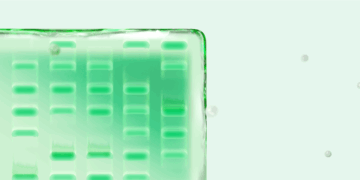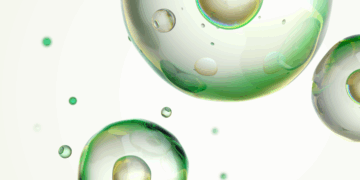Transferring proteins from the gel to a solid support is a critical step in western blotting. Even though it is a straightforward process, some degree of optimization is required, depending on the size of your protein and on the chemistry of your gels. Here we provide a few tips for efficient transfer of proteins from gels to membranes.
1
Know your transfer method
Understanding the different methods of transfer and which one would be optimal for your protein is the first step. Wet transfer, where the membrane sandwich is completely immersed in the transfer buffer in a buffer tank, is used for transferring proteins of broad molecular weights. In the semi-dry method of transfer, the buffer is restricted to the two stacks of filter paper covering the membrane. Semi-dry conditions are favorable for transferring proteins in the 30–120 kD range. A third method, the rapid semi-dry transfer has special buffer and material formulations that facilitate the transfer of proteins in as short a time as in 3–10 minutes. The rapid semi-dry method can be used for proteins with a broad range of molecular weights.
2
Optimize your transfer conditions
Whichever transfer method you choose, conditions need to be optimized for the best transfer efficiency. If considerable amounts of prestained protein standard is visible on the gel after transfer, it is best to stain the gel with Coomassie Brilliant Blue. This would give a benchmark for how much optimization may be required for effective transfer. Alternatively, you could use the stain-free method for protein quantitation. The stain-free method can be used to image gels before transfer and image the membrane after transfer, thereby enabling direct quantitation. Staining the membrane with dyes like SYPRO Ruby or Ponceau can give an idea of how much optimization is still needed.
3
Adjust buffers based on your protein
Whether you are using an existing lab protocol or one from a publication, you may need to recalibrate buffer formulations based on your protein of interest.
You can start with Towbin transfer buffer (25 mM Tris, 192 mM glycine, pH 8.3) and alcohol (20% methanol or 10% ethanol or 15% isopropyl alcohol) as the basic buffer for any of the proteins and recalibrate based on how it performs.
Varying the amounts of SDS and Alcohol
Concentrations of methanol and SDS can be adjusted to improve transfer efficiency. Alcohol increases binding of SDS-bound proteins to nitrocellulose, but decreases pore sizes in the gel. Eliminating alcohol from SDS-protein transfers results in considerably diminished binding. Adding SDS (up to 0.1%) to the transfer buffer increases the transfer efficiency of proteins, but reduces the amount of binding to the membrane. Therefore, if SDS is added to the transfer buffer, it is important to also include methanol (10–20%).
SDS also increases the conductivity of the buffer and the heat generated during transfer. This might result in denaturation of some proteins. Large proteins (>100,000 Da) denatured by SDS may transfer poorly if alcohol is added to the transfer buffer. Using a smaller pore size nitrocellulose membrane (0.2 µm), can be effective in eliminating this loss.
If your protein has a high molecular weight (MW) or high pI, you can try the following buffer options:
- Bjerrum and Schafer-Nielsen transfer buffer for SDS proteins using nitrocellulose (with methanol) or Zeta-Probe® membrane (without methanol) (Bjerrum and Schafer-Nielsen 1986):
48 mM Tris, 39 mM glycine (20% methanol), pH 9.2. Dissolve 5.82 g Tris and 2.93 g glycine [and 0.375 g SDS or 3.75 ml of 10% SDS] in distilled, deionized water (ddH2O). Add 200 ml of methanol; adjust volume to 1 L with ddH2O.
Do not add acid or base to adjust pH.
Note: This buffer is only for wet transfer and the Trans-Blot® SD semi-dry transfer cell. Do not use it with Trans-Blot® Turbo™ cassettes.
- Dunn carbonate transfer buffer for SDS-proteins using nitrocellulose (with methanol) or Zeta-Probe membrane (without methanol):
10 mM NaCHO3, 3 mM Na2 CO3 (20% methanol), pH 9.9. Dissolve 0.84 g NaHCO3 and 0.318 g Na2 CO3 (anhydrous) in ddH2O (add 200 ml of methanol); adjust volume to 1 L with ddH2O.
Do not add acid or base to adjust pH.
This is especially good for semi-dry applications.
- CAPS Buffer with 20 % Methanol:
10 mM CAPS (3-(cyclohexylamino)-1-propane sulfonic acid), 20% v/v methanol, pH 11. Mix 2.21 g CAPS in 600 ml of ddH2O, adjust the pH to 11.0 with NaOH. Add dd H2O to 800 ml. Add 200 ml methanol.
This buffer can be useful for proteins with >50 kD MW.
Note: CAPS 20% methanol buffer is recommended for wet transfer. For CAPS/Tris discontinuous buffer system in semi-dry transfer refer to Bio-Rad bulletin 2134.
4
Choose the right membrane
If you are transferring a low MW protein (<15 kD), use membranes with 0.2 µm pore size. For most other proteins, 0.45 µm pore size membranes can be used. Alternatively, PVDF membranes can be used.
PVDF is good for stripping and reprobing. For fluorescence western blotting, use low fluorescence PVDF (except for IR detection). Remember that methanol activation is needed for PVDF membranes.
Nitrocellulose is a cost-effective option and no methanol activation is required with these membranes. Nitrocellulose membranes work well for IR detection.
5
Adjust your transfer time
Irrespective of what is stated in the protocol, some optimization of transfer time may be needed for your protein.
Tank transfer
In general, we recommend 100V, 60 minute transfers unless you are using TGX™ gels. For TGX gels transfer at 100V for 30 minutes. To estimate whether there is an overtransfer, you can use two membranes: if there is some protein in the second membrane, decrease the time of transfer. Using an overnight transfer protocol could also yield better results.
Semi-dry transfer
Use 10–15 V for 15–30 min. Once the gel run is completed, immediately place the gel on the transfer stack and start the transfer. Do not rinse or soak the gel in water or buffer before transfer.
The same protocol can be used for Tris/Tricine gels as for Tris/glycine gels, though the time of transfer may have to be shortened to keep small proteins from blowing through the membrane. PVDF membrane with 0.2 µm pore size is ideal to reduce this possibility. Since small peptides tend to diffuse, equilibration time should be limited to less than 10 min.
Rapid transfer
Transfer for 7–10 min. Optimize according to your needs or the protein. Use manufacturer’s instructions for other conditions.
6
Optimize conditions when switching from one method to another
Tris-HCl or Bis-Tris gels to TGX gels:
TGX gels afford fast transfers compared to other gels. However, in some cases proteins may blow through the membranes, resulting in loss of proteins. To avoid this, the following conditions are recommended:
Change only the transfer time and no other parameter. In general, you need only 50% of the time (30 min) required for NuPAGE gels for proteins up to 250 kD. You might still need to tweak it.
TGX to Tris-HCl or Bis-Tris:
Double the transfer time (i.e. 30 minutes to 1 hour).
Short transfer time to overnight transfer time:
For semi-dry transfers with the Trans-Blot SD semi-dry transfer system, start with 10 V for 30 min or 15 V for 15 min.
For overnight transfers, a 30 V, 16-hr condition is recommended.
Tank to rapid transfer
Don’t equilibrate the gel before transfer; use it directly. If you are using PVDF membranes, be careful not to dry them out. Use the appropriate protocol, based on the MW of your protein, and then tweak the conditions.
For more details on different transfer methods, conditions, and troubleshooting tips, refer to Bio-Rad’s Protein Blotting Guide.
NuPAGE is a trademark of Invitrogen. SYPRO is a trademark of Life Technologies Corporation.
References
Bjerrum OJ and Schafer-Nielsen C (1986). Analytical Electrophoresis, M. J. Dunn, ed. (Weinheim, Germany: VCH Verlagsgesellschaft), p. 315.
Dunn SD (1986). Effects of the modification of transfer buffer composition and the renaturation of proteins in gels on the recognition of proteins on western blots by monoclonal antibodies. Anal Biochem 157, 144–153.



